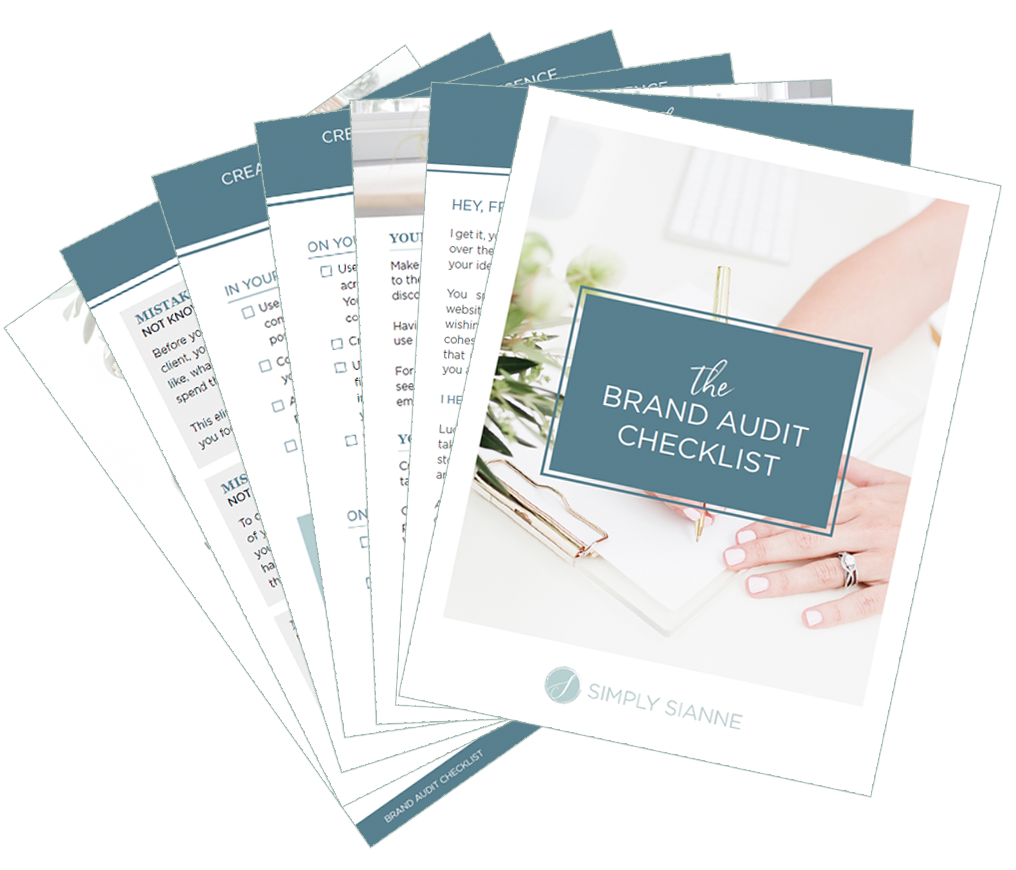I recently went live on Facebook with my friend, Carolina Guzik, to talk about all things branding and how creative entrepreneurs can build their brand.
Before we jumped into building a recognizable and consistent brand, I identified the differences between the various elements that make up one.
So, if you’re looking to build your brand or want to do a gut-check on the one you already have, let’s dive in!

WHAT’S THE DIFFERENCE?
Brand
Your brand is based on the emotions and experiences a customer or client has with your business. This is the relationship they have with you (as a brand).
It’s the initial gut reaction someone has when they hear your business’s name, and it’s the things they say about your brand when you’re not in the room.
You brand is the reputation it has out in the wild.
Regardless of what you say in your messaging, the brand is truly made up of the experiences your ideal clients have with your business.
This is where customer service and the user experience really affect the brand name.
A great example of a solid brand is Apple.
Whenever you ask someone to describe Apple, they typically say things like:
- User friendly
- Clean
- Easy to use
- Sleek
- Modern
- Forward-thinking
All of these words are used to describe the experience most people have when consuming Apple products. Note: the words being used to describe the brand are not the actual products they sell but the experience they provide.
Brand Identity
Brand identity is the first thing that comes to mind when most business owners think about branding.
Brand identity is the tangible items of a brand. It is comprised of the logos, typography, colors, imagery, and text that helps bring a brand to life.
Most business owners get so caught up on this step that they don’t consider all of the other elements needed to create a strong brand presence.
The brand identity is a piece of the pie but not all of it.
Related: You Logo is not your brand
In order to build a brand that speaks directly to your ideal client, the client must be at the forefront of your thoughts when designing and creating your brand identity.
Of course, if you are building a personal brand, the brand should be a reflection of you, but so many creative entrepreneurs forget to even consider who they are talking to and only focus on the brand elements representing them.
To make sure you are creating a brand that works for both you and your ideal client, you need to focus on the driving forces that overlap to develop your brand identity.
Branding
Branding is the process of building awareness and loyalty for your brand.
Let me repeat this: branding is the process of building awareness. It is the strategy businesses use to help their brands become recognizable.
You’re probably thinking, “wait, I thought that was marketing.”
Let’s break it down::
Marketing is the action of promoting or selling products or services, whereas branding is the process of building awareness.
Marketing tends to be short-term focused, whereas branding is typically focusing on the long-term goals.
Without getting too far off the branding path, I just wanted to add that branding, marketing, and sales all work very closely together and are often stacked ontop of one another in marketing funnels.
This example is an oversimplification of most funnels.

Now that you know the difference between brand, brand identity, and branding, we can jump into how to build a brand for your creative business.
If you haven’t already checked out this post, you may want to start there.
It goes over the five steps to build your brand.
Now, let’s go over a few common mistakes I see business owners make when cultivating their brands.
COMMON MISTAKES WHEN BUILDING YOUR BRAND
Mistake #1: Not Basing Their Ideal Client on a Real Person
Many brand strategists and entrepreneurs who have created successful businesses will often advise building an ideal avatar in order to really grow a business–and I totally agree!
In order to make sure you’re talking to your ideal client, you need to first know who those clients are.
What’s a common mistake I see new business owners making when identifying their ideal client? They are basing their avatars on imaginary people.
The business owner is making assumptions based on what they believe are the pain points and motivators of their ideal client; they often create an imaginary “Ashley” to bring their avatar to life.
The problem with this method is they aren’t vetting those thoughts with the actual wants, needs, desires, and fears of a real person.
If you’re just starting out, I think it is completely necessary to go with the flow and see who you’re attracting and take work as it comes, but after you have some data to work with (typically at the end of the year), evaluate and review why those clients came to you.
Identify what their wants, needs, desires, and fears were before hiring you. This will help you truly identify your ideal client and the type of messaging that will get you in front of their thoughts.
Mistake #2: Building Just the Brand Identity
All too often business owners get really caught up on the logo design of their brand but fail to think about the overall experience the brand is providing.
When I work with my clients one-on-one, we first identify their ideal customer as well as the emotions we want those customers to feel when consuming their brand.
Those keywords and emotions are the foundation of the brand identity.
Let’s revisit Apple.
The words people typically use to describe a brand, especially a brand like Apple, are indicators of their overall experience.
Words like “sleek” “modern” and “forward-thinking” are evident in their design–in-stores and online.
Use of a sans serif font and a clean user friendly website all feed into the emotions and keywords we use to describe Apple’s brand.
Those same words also describe the products we all know and love.
Keeping those brand emotions and keywords at the forefront of your design is important in building a consistent and recognizable brand.
Mistake #3: Not Being Consistent
Okay, so now that you know branding is the process of generating awareness, let’s dive into mistake #3: inconsistency.
I often see business owners try branding themselves without being consistent, and I promise: your inconsistency is hurting your brand.
If your business name is inconsistent across various social media handles, your website URL, and your logo, there is no doubt going to be a disconnect with your audience.
If you’re inconsistently showing up on your social media channels and haphazardly sharing what you offer, it makes it difficult for your ideal client to trust you.
Because when they don’t know when and where to expect you, they aren’t sure if you’re still in business and that creates doubt.
Consistently show up.
Show up on the platforms your ideal client is hanging out on. Build the “like, know, trust” factor and create a recognizable brand by being consistent.
Consistency doesn’t have to be every single day–it just means there is some sort of rhythm to your content and to where you hang out.
It means you are using the same headshot and logo across all platforms.
Consistency means creating credibility with your branding.
WATCH THE INTERVIEW
Now that you know the difference between brand, brand identity, and branding as well as the three mistakes to avoid when building your brand presence, you can go out there and rock your branding like the boss you are!
LISTEN TO THE PODCAST
If you’re on the go and would prefer to listen to just the audio, take us with you!
GRAB THE BRAND AUDIT CHECKLIST
Need a little more guidance on building your brand? Download the brand audit checklist:

download the brand audit checklist
transform your business and create a consistent brand that clearly communicates what you do and who you do it for
What’s one thing you learned from this article about branding? Share in the comments below!
xo,
Sianne





